The Hanging Hills of Meriden: Legend & Geology
“It may seem strange that a man of science should believe a thing of this kind—an idle tale for the ignorant and superstitious you will say—but I do believe it,” a young geologist wrote in 1898. The tale warned about a curse involving a black dog said to haunt the West Peak of the Hanging Hills of Meriden, an apparition that spelled death and disaster, one some believe wanders the hills even today. “And if you would know why, listen…”
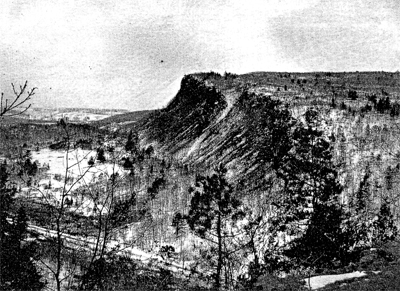
The peaks of the Hanging Hills of Meriden (above) as pictured in “The Black Dog,” a firsthand account of two geologists’ ill-fated encounters with “a short haired black dog of moderate size” seen around West Peak, written by W.H.C. Pynchon and published in the Connecticut Quarterly.
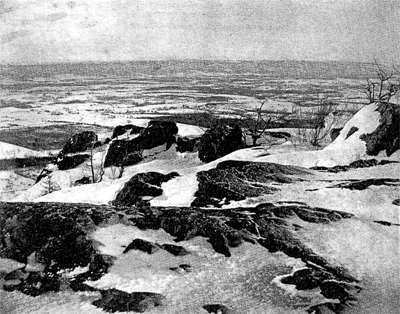
“When winter winds roar…when the rocks stand out black through the drifts…the West Peak (above, as pictured in Pynchon's account) has a look of menace hard to describe. Weird tales have sprung up…one is especially to be mentioned—the story of a black dog seen at times upon the peak.
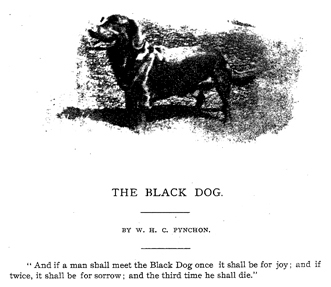
“Many have seen him once, a few twice—none have ever told of the third meeting,” the young geologist wrote in describing the dog’s ethereal qualities. “Men have seen it bark, but have heard no sound; and it leaves no footprint behind it on the dust of summer or the snow of winter.” Its sight was said to mean certain death for anyone so unfortunate as to look upon it for a third time.
The curse of the black dog—geologists fall victims?
The young geologist encountered the dog, and years later its legend, during his first trip to West Peak made one spring in the late 1800s. “I was then a student at Harvard, and the work in geology I had taken up made it desirable for me to visit the locality.” Connecticut Valley traprock ridges, including West Peak, had held a special fascination for local geologists such as Benjamin Silliman and Edward Hitchcock since the 1820s.
“Hoary evidences of ancient volcanic action,” was how the young geologist described the hills. “Countless years have elapsed since the great tide of molten lava rolled over the region. Years fewer, but still countless, have passed during which the shattered and tilted remnants of the lava sheets have watched over the land. Deep gorges divide the masses into separate mountains, lonely and desolate, and the most desolate and the most conspicuous of all is the West Peak.”
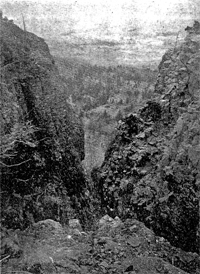
After the young geologist rode up to West Peak and started collecting samples of “vesicular” lava, the dog appeared to him. He greatly enjoyed the dog's company until dusk, when it “stopped, looked back at me a moment, and quietly vanished into the woods.”
Three years later, the young geologist returned to West Peak early in February with a friend, Herbert Marshall, a geologist with the fledgling United States Geological Survey. The night before, Marshall told about how he had also seen the dog, not just once, but twice before, and “laughed at the legend, saying he did not believe in omens.”
In the morning they made an ascent of the south face of West Peak in the cold and snow, until they reached “deep clefts” in the cliffs that the young geologist would later compare to the biblical “Valley of the Shadow of Death.”
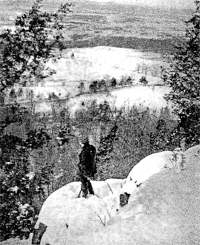
Marshall (above, as pictured in Pynchon's account) was in the lead when he abruptly stopped. “There on the rocks above us, stood a black dog,” the young geologist wrote. It was the second time he had seen it, but for Marshall, the third. “We saw his breath steaming from his jaws, but no sound came through the biting air.” Marshall turned white and uttered: “’I did not believe it before. I believe it now.’ And then, even as he spoke, the fragment of rock on which he stood slipped. There was a cry, a rattle of fragments falling—and I stood alone.” Rescuers later found Marshall’s body at the bottom of the ravine, bloodied and broken, and watched by a black dog.
After witnessing the death of his friend, and at the risk of encountering the dog for a third time himself, the young geologist felt compelled to return to West Peak and to carry on the work of the geological survey. “I must die sometime,” he wrote. “When I am gone this paper may be of interest to those who remain, for, in throwing light on the manner of my death, it will also throw light on the end of the many victims that the old volcanic hills have claimed.
Six years later, the young geologist went missing following a trip to the hills. It was several weeks before his body was found in the same ravine where Marshall had fallen below West Peak. According to a newspaper report, “the body was found on almost the identical spot where his friend, Herbert Marshall, met his death six years before…the fifth man who has lost his life on the range within thirty years.” Whether or not he had seen the black dog a third time that fateful day we will never know.
Some wonder if the black dog still prowls West Peak today, looking to claim yet more victims, perhaps such as the climber who lost his life on the mountain as recently as Thanksgiving Day, 1972.
Fact & Fiction
While the tale of the curse of the black dog is the stuff of legend, observations made about the geology of the Hanging Hills in Pynchon's account ring true. The hills, for example, are correctly described as "evidences of ancient volcanic action." Geological studies made in the past, as well as new work being conducted today, show the ridges formed during a series of three periods of volcanism that occurred in the region some 200 million years ago. Exposures of all three of the lava flows, the Talcott, Hampden, and Holyoke Basalts, occur in close proximity in the hills and surrounding areas.
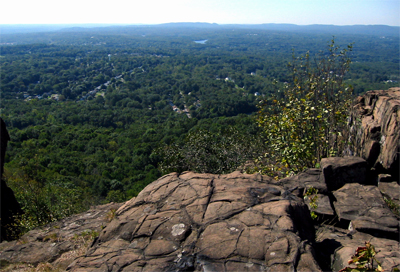
A view southward from West Peak (above) photographed last October. The Sleeping Giant can be seen in the photo centered on the horizon.
"The ridges are all made of the Holyoke Basalt flow," writes geologist Greg McHone in his guide, Great Day Trips to Discover the Geology of Connecticut. Rocks of the Talcott Basalt can also be found along the hills' southern and western flanks; portions of the Holyoke Basalt can be found to the northeast.
Pynchon's account notes that "the cliffs are pierced by deep clefts" and valleys. These notches, visible from the hilltops and highways below, are the results of faults which have split and shifted portions of the old lavas, and made the hills more foreboding. "Since the flow tilts to the east," Greg explains, "yet reappears in several ridges, there must be faults between the ridges that have offset the ridges to lower levels as you go from east to west.
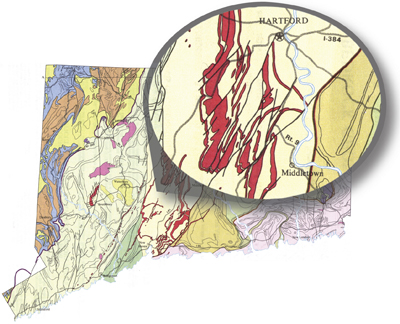
The faults (seen above as thin black lines) separating the peaks (red areas) are shown on the 1985 Bedrock Geologic Map of Connecticut (above) developed by renowned geologist John Rodgers of Yale University, and published by the Connecticut Geological & Natural History Survey.
In an area north of Meriden, faults split portions of the Metacomet Ridge. Since ancient time, water and glacial ice have worked to erode and deepen the ravines Pynchon described as separating the Hanging Hills. The large lake just north of Hubbard Park in Meriden, Merimere Reservoir, now fills one valley between East Peak and South Mountain. As Greg describes in his book, Hubbard Park today provides excellent access to the hills, for anyone interested to explore the hills, hikers and drivers.
Along the road that leads from the main area of the park and up to the peaks are examples of "vesicular lavas" like those Pynchon describes the young geologist collecting on the day he first saw the black dog. Small bubbles of hot gas trapped in the molten rock during the time the ancient lavas flowed remain today as pockmarks and small voids commonly seen in local basalt and known as gas vesicles (below).
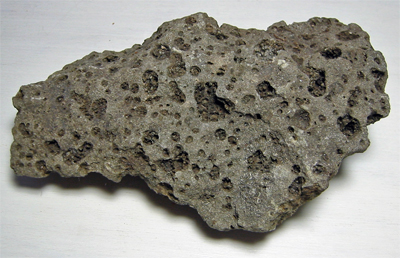
If you make your way to the top of the peaks there are other interesting features of the basalts that can be seen. Narrow lines, raised and irregular, are apparent in the surface of the ridge tops. These are evidence of polygonal columnar jointing. These natural designs formed first as the lavas cooled in columns perpendicular to the direction of flow and shrunk and cracked. The vertical cracks, or fractures, later filled with minerals during the long periods of sedimentation in the Connecticut Valley that followed.
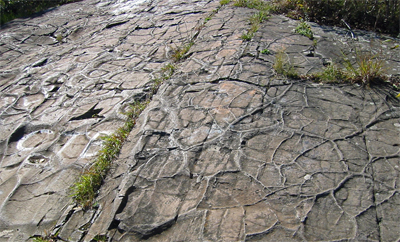
Evidence of much more recent glacial erosion of the ridges can be recognized as scrape marks seen in the rocks running north to south. The gouges were worn in the rock by glacial till, stone fragments and sediments that accumulated in glacial ice as it spread southward, worked to scour the traprock ridges and surrounding landscape.
Of course, exercise caution in making any exploration of the Hanging Hills. Whether you see the black dog or not, West Peak is a hazardous place under the best of circumstances.
11 Comments:
wicked cool!
Just passing by while trying to find blogs that deals with the outdoor life and I find this particular post of yours fascinating to read. I feel as if I were watching an episode of the twilight zone--this legend of the "BLACK DOG" gives me the creeps!
I was on top of that mountain, and a black dog did appear out of no where. No dog owner was around, it was very odd, and the dog was just all of a sudden, right behind me. I never heard a thing. I took a photo of it. I'll have to get it to you somehow.
Sarge@vishus.org
The Black Dog has fascinated me since I was a child... One day I hope to travel to Meriden to look into this creature myself. If you have any detailed info about it (ie. newspaper reports, esp. newer ones) I'd be most appreciative if you could contact me- nwilson@westnet.com.au
I was born and grew up in Meriden and in the early 80s my friends and I after getting out of work decided to take a drive up to Castle Craig.It was after midnight in october it was very foggy driving up the Castle Craig road and hard to see the road on the way up. By the way... it wasnt until the mid to late 80s the town started locking the entrance to Castle Craig road.Anyway... I was leading the way and my two friends were following me in their cars as I rounded the last turn before entering the Castle Craig parking lot the fog suddenly cleared and out of no where I black dog runs out from the side of the road in front of my car I hit my brakes and swerve as I watched the black dog run off into the woods on the other side of the road. I pull up into the parking lot jump out of my car my friends pulling along side of my car and I yell "did ya see the freaking black dog" and my friend who was right behind me said "Yeah !" He was from Wallingford and never heard about the "black dog legend" My other friend didnt see it.We walked down the parking lot over to where the dog ran out and went to the other side of the road to listen to see if we could hear the dog in the woods we couldnt hear a thing.So we walked back up to our cars to drink some beers and I told them the black dog story.Then we started asking the question "what the hell was a dog doing way the hell up there ?" There were no other cars in the parking lot we didnt see any in the bottom parking lot or on the way up ! Needless to say after a few more minutes we all said lets get the hell out of here ! Really if anybody is familiar with Castle Craig road it is roughly 3 or so miles winding up to the C.C. parking lot if I am not mistaken. So why or what the hell was a dog doing atop castle craig ??? Another thing I hiked the cliffs and trails around castle craig I doubt the dog came up through the cliffs and steep rocking trails.So why would a dog run all the way up the castle craig road ? Very strange indeed ! One more thing on the way back down the road we looked for the dog but never saw it ! It was like it vanished !
I grew up and currently live in Meriden. I live about half a mile from Hubbard Park, which is where the endtrance to the road you travel to get to castle craig, and I have heard many stories about the black dog. I never actually believed until I did see it though. I just thought it was a myth, and urban legend. But I am positive I saw it. I was in the third grade and my school took a trip to climb the mountain. I saw it, and so did a few of my friends, but only a few. Whether the dog bring death, sorrow, or good fortune, I can not say. But as to the question of its exsistance, that is 100% true.
Wow the first time I herd about this black dog was this morning my my boyfriend and I was really creeped out. I wanted to check this out my self so I read this and now im so scared to go hicking up there again. My boyfriend said he wants to see it now and wants me to go but I think if i see the dog i would piss myself. Im also really scared of black dogs ever since i watched the omen iv been even more scared. I cryed durning it but yeah ahhhhhhhhhh creepy!!!
My frineds are trying to go see it. Caitlins mom was gunna bring us, but Im goign out of state. Im missing a lt of things I waned to do, that all happened, to be, odf course, this week. I'll post again if they see it.
October 31, 2009. Uncanny date, no? Last week I hiked the trail up from Hubbard Park to the the road and encountered a dog on the path. I did not venture close since I had my own dog with me. I also never heard of this legend until today. On Sunday Oct. 25 I hiked the route again with my dog to the West Peak. I slipped and fell in a small crevice between two outcroppings and came within inches of falling off the peak. Only my curiosity of the distance traveled prompted me to read about the legend in my trail book...even a non-believer must take pause.
This famous account of the Black Dog, published in the April-June, 1898 issue of Connecticut Quarterly (Volume 4), is on Google books. Link: http://books.google.com/books?id=n_8aAAAAYAAJ&source=gbs_similarbooks and go to page 153. Pynchon recounts a long tale that ends with his friend and fellow geologist slipping to his death after seeing the dog three times on Feb. 5 of an unspecified year. Since it was Pynchon’s second sighting, “it shall be for sorrow” and for Marshall, “and the third time he shall die.” Fanciful stories would like to say that Pynchon returned to the site at a later time and slipping to his death on the same spot. Pynchon actually died Jan. 2, 1910 in Oyster Bay, L.I., information I verified from two different websites, one of which is here: http://www.americanancestors.org/novelist-thomas-pynchon/
There are a couple of oddities about the Pynchon article in Connecticut Quarterly. One oddity is that he refers to years as 18–, a literacy style of the time used in stories to keep them somewhat timeless. The other oddity is that the article is full of pictures of the ill-fated trip, yet there are no pictures of the black dog, which supposedly followed them the whole day.
From a lack of common sense point of view, they were up there in February in icy and snowy conditions, presumably without any sort of crampons. I will not hike at West Peak under anything but dry conditions because there are far too many places to slip and go over the edge. I have never seen the legendary black dog up there and I have a friend who does trail maintenance there, and he has never seen this mysterious mutt either.
I don't want to spoil a good story, but Pynchon did not die at West Peak.
These are two historical documents that prove Pynchon did not die in Meriden.
This is a genealogy website that gives information about Pynchon’s family history. It reads in part:
“William H. C. Pynchon had prepared at Rogers High School in Newport, RI, was “second in class standing and valedictorian” at Trinity, received an M.A. from Harvard in 1893, was an instructor in geology at Trinity for several years, and moved to Oyster Bay as its “civil engineer and surveyor,” dying there 2 Jan. 1910.
This website may be found at this address:
http://www.newenglandancestors.org/research/services/articles_gbr48.asp
This document is a list of people who died in the town of Oyster Bay, Long Island, N.Y.
The book is titled:
Index to Register of Deaths
Town of Oyster Bay
(1881-1920)
Compiled by John E. Hammond, Town Historian
The book has this listing:
Pynchon, W.H.C. 1/2/1910
This document may be found at this web address.
http://www.oysterbaytown.com/vertical/Sites/%7B7D6BDBFB-65E8-4A80-B369-DE0267DC78CB%7D/uploads/%7B80953A9E-FB80-4B32-BC97-757A571AC998%7D.PDF
Post a Comment
<< Home